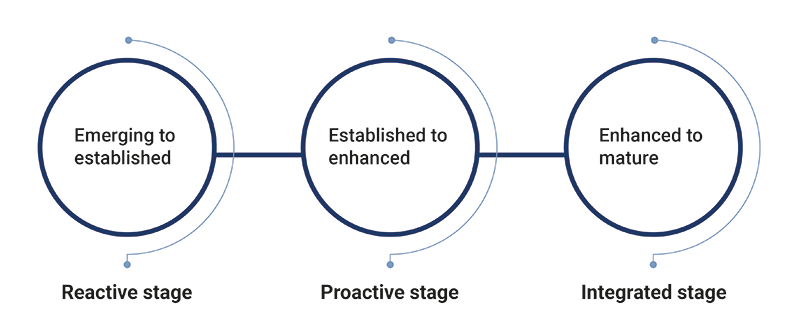Digital maturity model
Use the maturity model for digital transformation to assess digital maturity levels for all aspects of your organisation and identify areas for improvement.
The maturity model for digital transformation provides a structure to help UK HE providers assess their digital maturity across all aspects of business. The structure aligns with the Jisc framework for digital transformation.
When identifying digital maturity HE providers need to benchmark themselves against the sector, as well as set their own baseline from which to move forward. Defining digital maturity is an important step in producing a digital transformation strategy and creating actionable plans.
The model provides a common language for HE providers to discuss digital transformation and share best practices across the organisation and the sector.
The third level in our maturity model represents a sector benchmark of ‘what good looks like’.
Maturity levels

The model consists of three levels of digital maturity. They can be assessed against each aspect of activity identified in the framework. The model provides a description of each level for all areas of the framework to illustrate the benefits and outcomes of progressing through the levels. The description is also intended to help organisations identify their own levels.
Emerging to established – reactive stage
- Lack of strategic digital leadership
- Short-term investment
- Unintegrated systems and operations
- Lack of innovation
- Lack of widespread stakeholder understanding and engagement
- Dispersed, project-based digital activities
- Lack of strategic digital leadership
- Short-term investment
- Unintegrated systems and operations
- Lack of innovation
- Lack of widespread stakeholder understanding and engagement
- Dispersed, project-based digital activities
Established to enhanced – proactive stage
- Developing a proactive strategic approach
- Enabling effective digital leadership
- Making efforts to integrate systems and operations
- Engaging and upskilling all stakeholders
- Moving towards service delivery model
- Developing a proactive strategic approach
- Enabling effective digital leadership
- Making efforts to integrate systems and operations
- Engaging and upskilling all stakeholders
- Moving towards service delivery model
Enhanced to mature – integrated stage
- Comprehensive and integrated strategic approaches
- Effective digital leadership
- Long-term and adaptable planning and investment
- Integrated, efficient systems and operations
- Engaged, informed and appropriately skilled stakeholders
- Partnership approaches to innovation
- Longer term service delivery model approach (less project based)
- Comprehensive and integrated strategic approaches
- Effective digital leadership
- Long-term and adaptable planning and investment
- Integrated, efficient systems and operations
- Engaged, informed and appropriately skilled stakeholders
- Partnership approaches to innovation
- Longer term service delivery model approach (less project based)
Using the maturity model
“It was interesting to see the difference in attitudes between senior leaders and the project team in relation to some aspects of digital maturity… it really helped us to collectively reflect on our results.”
Laura Hallett, executive director strategic project services, University of Hull
We have segmented the model down into the six element headings of the framework to help organisations break down the task. However, it is important to note that, because many aspects occur across the different elements, senior leaders need an overview of maturity levels across the whole organisation.
The model is a practical document that will evolve into a specific record of your organisation's maturity levels and progress. We offer it as a series of word templates so you can customise it fully to reflect your organisation's baseline state. It uses drop-down lists that prompt you to identify the maturity level for each area and also asks you to identify your progress for that area as follows:
- Not started/not planned
- Not started/planned
- Started
- Nearly there
- Done – ongoing review
Download a pdf or Word version of the maturity model, which you can use and adapt to assess your own digital maturity and identify your progress towards achieving maturity for each area.
Download the maturity model for digital transformation (pdf)
Download the maturity model for digital transformation (docx)
Download the maturity model for organisational digital culture (pdf)
Download the maturity model for organisational digital culture (docx)
Download the maturity model for knowledge creation and innovation (pdf)
Download the maturity model for knowledge creation and innovation (docx)
Download the maturity model for knowledge development (pdf)
Download the maturity model for knowledge development (docx)
Download the maturity model for knowledge management and use (pdf)
Download the maturity model for knowledge management and use (docx)
Download the maturity model for knowledge exchange and partnerships (pdf)
Download the maturity model for knowledge exchange and partnerships (docx)
Download the maturity model for digital and physical infrastructure (pdf)
Download the maturity model for digital and physical infrastructure (docx)
Complementary maturity models
Our maturity model covers the whole business of an HE provider. We know that other maturity models can inform specific aspects of work, like data or enterprise architecture and we have developed a reference guide of other maturity models that might be used already, or may be helpful to focus on specific areas in more detail. We have also highlighted non-UK initiatives in this area.
Download maturity model mapping to complementary models (docx)
Download maturity model mapping to complementary models (pdf)
Next section: Developing an organisational roadmap
Using our action plan templates you can develop an organisational roadmap or more focused action plans.
This toolkit is made available under Creative Commons License (CC BY-NC-SA).